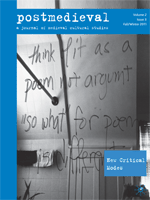postmedieval, Becoming Media 3.2 is now published !
This special issue of postmedieval: a journal of medieval cultural studies will also feature an open "crowd" review, and a special forum on the future of new models of scholarly peer review. See here for more information.
Volume 3, Issue 1: Becoming-Media
Editors: Jen Boyle, Coastal Carolina University, USA and Martin K. Foys, Drew University
Grappling both with the “post” and the medhyo or “middle/medium” of post-medieval, this issue will turn on a series of questions and explorations of the notion of “becoming-media” within and in conversation with medieval and early modern contexts. Becoming-media refers in one sense to our dependence on the recursive circuitry and tangle of technologies, bodies, narratives, spaces, and mediating technics, across historical periods and across literary, scientific, philosophical, and theological modes of expression. Recent theoretical turns in “new media” studies have raised questions about the limits of embodiment, the remediation and interfacing of the human/machine nexus, and the reconstitution of spatial and temporal modalities with the emergence of a digital culture. Yet, the casting of new media studies as itself “new” raises troubling questions. To what extent is mediation ever “new”? Indeed, as the medhyo at the center of “medieval” would suggest, mediation appears as an always incomplete “middling” and “meddling” – always becoming, to itself and something other than itself; a troubling, meddling, unstable go-between. This second sense of becoming-media extends questions about the mediating artifact within its historical context to include issues of embodied and historical temporality; periodization as “meddling”; the feedback loop of technics-consciousness; the glance, glimpse, and touch of the mediated image as political and aesthetic affect; and the unstable registers of the trans/hyper-mediation of multiple past-present-futures.
Contributors
- Seeta Chaganti (University of California, Davis): “Danse Macabre in the Virtual Churchyard”
- Eddie Christie (Georgia State University): “Writing in Wax, Writing in Water"
- Arne Flaten (Coastal Carolina University):"Reproducible Media(s) in the Early Fifteenth Century (Mostly Italian)"
- Julia Lupton (University of California, Irvine): "Thinking with Things: Hannah Woolley to Hannah Arendt"
- Eugene Thacker (The New School): “The Wayless Abyss: Mysticism and Mediation”
- Whitney Trettien (Duke University): “Becoming Plant: Magnifying a Microhistory of Media Circuits in Nehemiah Grew's Anatomy of Plants (1682)”
Book Review Essay
- Juliet Fleming (New York University)
See new issue, New Critical Modes
See the latest issue of postmedieval, "The Animal Turn," at Palgrave...


